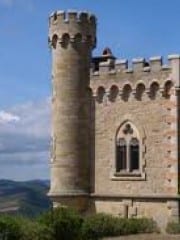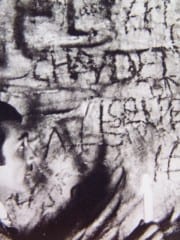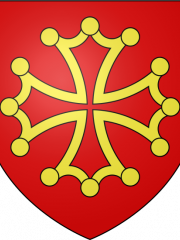Investigation
Is a deserted village the best clue to the whereabouts of the Grail Castle?
The Grail and the story of King Arthur is a myth, in the sense that things got added to it. The first Grail account did not mention the nature of the Grail, whereas Wolfram von Eschenbach particularly identified it with a black stone, speculated by some to be a meteor, by others to be a cousin of the Ka’aba stone.
The story of the Grail is like the myth of Jesus: From an interesting person, believed to have resurrected, he grew into the son of god, to the child of a virgin birth, its father the Holy Spirit. One aspect of the Grail mythology is the addition of the “Grail castle” to the original mythology.
The Holy Grail: Imagination and Belief
At the climax of the French prose romance, The Quest of the Holy Grail, Sir Galahad looks into the dish that was the object of the long and perilous search by himself and his companions, Sir Perceval and Sir Bors. This is his report:
For now I see openly what tongue cannot describe nor heart conceive. Here I see the beginning of great daring and the prime cause of prowess; here I see the marvel of all other marvels.
Fascination with the Grail
The reality behind the myth...
Sagas describe the Holy Grail as a chalice with fairy-tale powers; it’s been the inspiration for countless tales, legends and also works of art. And it is both a stranger to the Christian body of thought -- and yet somehow connected with Christianity in mysterious ways. What is it about the "Holy Grail"? Why is it still the subject for mainstream movies like Indiana Jones and the Last Crusade and The Fisher King? Is there something more substantial behind the Grail than simple legend? If we can delve deeper into the true meaning of the Grail, the core of many poems, legends, novels, and fairy tales may become apparent.
The more seriously someone undertakes to approach the subject "Grail" -- because he feels touched personally by it -- the more certainly will he come up against questions such as whether or not the knowledge about the Grail can be traced back to some revelation… A revelation handed down out of a mythical distant time, but weighed down, proliferated and falsified on its way through time, through the world and the life of countless generations. Let us begin at the beginning...
Holy Grail
Since the publication of The Da Vinci Code the debate rages as to what and where the true Holy Grail exists
Taken as a whole, the various renditions of the Holy Grail legend, whether they derive from Europe or Asia, imply that there are many forms that the Holy Grail can take.
These legends assert that the Holy Grail can be anything from the platter mentioned by Chrétien de Troyes, the first author of the Holy Grail legend, to the Cup of Christ alluded to by Robert de Boron, or even the Stone of Heaven mentioned by Wolfram von Eschenbach in Parzival.
Richard Stanley
Richard Stanley is the award-winning South African-born filmmaker, who made a name of himself with his first feature film, the scifi-movie Hardware. A low budjet movie about a mad-dog android loose in an apartment was released in 1990. Critics slammed it as a Terminator rip-off, yet the film became a financial success. The 1,5 million dollar budjet was paid back quite handsomely and continuation was imminent.
In 1992, Stanley followed Hardware with Dust Devil, a story based on the myth of a Namibian serial killer. A fallout with the distributors led to the recutting of the US version, while the bankruptcy of the British-based production company Palace Pictures temporarily shut the postproduction down in Europe and the film remained mauled or unfinished, depending how you look at it. Finally Stanley himself managed to finance a new, restored print from the original negative, which has later gained a cult following similar to Hardware.
Еhe church's war on the cathars
During the eleventh and twelfth centuries, the region known as the Languedoc, spreading approximately southward from the Loire to the Pyrenees down into Arragon and eastward to the Rhone, became the most highly civilized area of Western Europe. Its fertile soil and pleasant climate provided the means for a leisurely life. The Rhone and the Garonne were notable routes of communication and the passage of many Crusaders on their way to the East gave an immense stimulus to trade. Above all the Moslem conquest of Spain had brought the influence of Arabic culture. The larger cities had schools of medicine, mathematics and astrology where Arabian scholarship was imparted. Jews were not debarred from public life and were highly respected as doctors and teachers. The Catholic Church no longer held the monopoly of knowledge; and were gradually losing their power hold in the Languedoc.
Invisible Eagle and NS Occult History, by Alan Baker
While in Berlin, [Karl Maria] Weisthor worked with the author and historian Otto Rahn (1904-1939), who had a profound interest in medieval Grail legends and the Cathar heresy. In 1933, Rahn published a romantic historical work entitled Kreuzzug gegen den Gral (Crusade Against the Grail), which was a study of the Albigensian Crusade, a war between the Roman Catholic church and the Cathars (or Albigensians), an ascetic religious sect that flourished in southern France in the twelfth and thirteenth centuries. The Cathars believed that the teachings of Christ had been corrupted by the Church -and, indeed, that Christ was exclusively a being of spirit who had never been incarnated in human form.
Thule, the Priory of Sion, and Otto Rahn
Conspiracy buffs have long been interested in the Nazis for their occult connections, and in recent years the south of France has garnered interest for a quite different supposed occult conspiracy, yet the two are rarely connected.
In an interview with Peter Levenda, Dagobert’s Revenge Magazine hit on the figure of Otto Rahn, grail researcher, who, after having completed a book on the grail mysteries of south France for the Nazis mysteriously died in the Pyrenees. It was also pointed out that around the time that Otto Rahn, who was a skilled mountain climber, was in all probability killed by the Nazis, a figure by the name of Karl Maria-Wilgut, known as Weisthor, who was a mystic employed by the SS, was relieved of his duties and gradually retired from public life.
In the article, the story was left as one of the many mysterious deaths surrounding whatever lies around Rennes-la-Chateau, but the truth of the matter can indeed be reconstructed, and gives some good insight into the forces at work in these two realms.
Отто Ран и поиски Святого Грааля
Отто Ран (1904-1938 гг.), о котором говорили как о талантливом молодом литераторе и историке, был одной из действительно ярких личностей этого века. До своей загадочной смерти в возрасте 35 лет он успел написать две книги о катарах южной Франции: "Крестовый поход против Грааля" ("Kreuzzug gegen den Gral") и "Двор Люцифера" ("Luzifers Hofgesind"). О его жизни и трагической смерти ходят легенды. Хотя его книги оказали влияние на таких известных русскому читателю авторов как Тревор Равенскрофт (Trevor Ravenscroft) и Жан-Мишель Анжебер (Jean-Michel Angebert), на русский язык они никогда не переводились. В бестселлере 1982 года "Святая кровь, святой Грааль" (Holy Blood, Holy Grail - в русском переводе "Священная загадка") имя Отто Рана упоминается в небольшом, но интригующем примечании.
Otto Rahn and the Quest for the Holy Grail
Otto Rahn (1904-1938), described as a gifted young author and historian, was one of this century's truly fascinating figures. Prior to his mysterious death, at age 35, he wrote two books about the Cathars of southern France: *Kreuzzug gegen den Gral* ("Crusade Against the Grail") and *Luzifers Hofgesinf* ("Lucifer's Court"). Legends continue to surround both his life and tragic death. While his books influenced such authors as Trevor Ravenscroft and Jean-Michel Angebert, they were never translated into English. In the 1982 best selling book *Holy Blood, Holy Grail*, Otto Rahn's name appears in a small but intriguing footnote. Otto Rahn believed that he had found the location of the Holy Grail Mountain, the Montsalvat of legend, in the Cathar mountain fortress of Montsegur in the French Pyrenees. He was, says Prof. Joscelyn Godwin, "largely responsible for the mythological complex that associated the Cathars and Montsegur with the Holy Grail and its Castle."
Norma Lorre Goodrich in her own highly acclaimed work *The Holy Grail* pays tribute to Otto Rahn's "Crusade Against the Grail" describing it as "a wonderful book, a monument to this German idealist author, who died mysteriously during a descent in the Alps."










Comentarios recientes
hace 13 años 16 semanas
hace 13 años 16 semanas
hace 13 años 16 semanas
hace 13 años 17 semanas
hace 13 años 20 semanas
hace 13 años 25 semanas